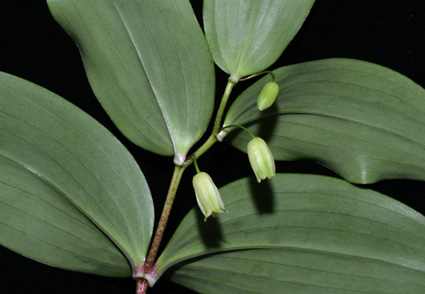Abstract
Through morphological observations and phylogenetic analysis of plastid genomes, Polygonatum binatifolium has been confirmed to belong to the genus Heteropolygonatum, supporting its transfer from Polygonatum to Heteropolygonatum. This taxonomic reassignment establishes it as the thirteenth species in the genus, with the new designation of Heteropolygonatum binatifolium.
References
- Bao, W.K., Yuan, Y.F., Liu, C.L. & Tamura, M.N. (1999) A new species of Heteropolygonatum (Convallariaceae-Polygonateae) from Sichuan, China. Acta Phytotaxonomica et Geobotanica 49: 143–146.
- Bianchini, G. & Sánchez-Baracaldo, P. (2024) TreeViewer: Flexible, modular software to visualise and manipulate phylogenetic trees. Ecology and Evolution 14: e10873. https://doi.org/10.1002/ece3.10873
- Capella-Gutiérrez, S., Silla-Martínez, J.M. & Gabaldón, T. (2009) trimAl: a tool for automated alignment trimming in large-scale phylogenetic analyses. Bioinformatics 25: 1972–1973. https://doi.org/10.1093/bioinformatics/btp348
- Chao, C.T., Tseng, Y.H. & Tzeng, H.Y. (2013) Heteropolygonatum altelobatum (Asparagaceae), comb. nova. Annales Botanici Fennici 50: 91–94. https://doi.org/10.5735/085.050.0117
- Doyle, J.J. & Doyle, J.L. (1987) A rapid DNA isolation procedure for small quantities of fresh leaf tissue. Phytochemical bulletin.
- Floden, A.J. (2014) New names in Heteropolygonatum (Asparagaceae). Phytotaxa 188: 218–226. https://doi.org/10.11646/phytotaxa.188.4.4
- Floden, A.J. (2017) Molecular phylogenetic studies of the genera of tribe Polygonateae (Asparagaceae: Nolinoideae): Disporopsis, Heteropolygonatum, and Polygonatum. PhD diss., University of Tennessee. Available from: https://trace.tennessee.edu/utk_graddiss/4398 (accessed 22 January 2025)
- Floden, A.J. (2018) Heteropolygonatum hainanense (Asparagaceae), a new species endemic to Hainan (China). Phytotaxa 369: 59–62. https://doi.org/10.11646/phytotaxa.369.1.8
- Hance, H.F. (1883) Disporopsis, genus novum Liliacearum. The Journal of Botany, British and Foreign 21: 278.
- Jin, J.J., Yu, W.B., Yang, J.B., Song, Y., dePamphilis, C.W., Yi, T.S. & Li, D.Z. (2020) GetOrganelle: a fast and versatile toolkit for accurate de novo assembly of organelle genomes. Genome Biology 21: 241. https://doi.org/10.1186/s13059-020-02154-5
- Katoh, K., Rozewicki, J. & Yamada, K.D. (2019) MAFFT online service: multiple sequence alignment, interactive sequence choice and visualization. Briefings in Bioinformatics 20: 1160–1166. https://doi.org/10.1093/bib/bbx108
- Kearse, M., Moir, R., Wilson, A., Stones-Havas, S., Cheung, M., Sturrock, S., Buxton, S., Cooper, A., Markowitz, S. & Duran, C. (2012) Geneious Basic: an integrated and extendable desktop software platform for the organization and analysis of sequence data. Bioinformatics 28: 1647–1649. https://doi.org/10.1093/bioinformatics/bts199
- Linnaeus, C. (1753) Species Plantarum. Laurentii Salvii, Holmiae, 1200 pp.
- Meng, Y., Nie, Z.L., Deng, T., Wen, J. & Yang, Y.P. (2014) Phylogenetics and evolution of phyllotaxy in the Solomon’s seal genus Polygonatum (Asparagaceae: Polygonateae). Botanical Journal of the Linnean Society 176: 435–451. https://doi.org/10.1111/boj.12218
- Miller, P. (1754) The gardeners dictionary: containing methods of cultivating and improving all sorts of trees, plants, and flowers, for the kitchen, fruit, and pleasure gardens, as also those which are used in medicine: with directions for the culture of vineyards, and making of wine in England: in which likewise are included the practical parts of husbandry, ed. 4. Published by the author, London, without pagination. 559 pp. https://doi.org/10.5962/bhl.title.79061
- Minh, B.Q., Schmidt, H.A., Chernomor, O., Schrempf, D., Woodhams, M.D.,Von, H.A. & Lanfear, R. (2020) IQ-TREE 2: new models and efficient methods for phylogenetic inference in the genomic era. Molecular Biology and Evolution 37: 1530–1534. https://doi.org/10.1093/molbev/msaa015
- Nie, L. & Chen, G.X. (2017) Heteropolygonatum wugongshanensis (Asparagaceae, Polygonateae), a new species from Jiangxi province of China. Phytotaxa 328: 189–197. https://doi.org/10.11646/phytotaxa.328.2.10
- Qu, X.J, Moore, M.J., Li, D.Z. & Yi, T.S. (2019) PGA: a software package for rapid, accurate, and flexible batch annotation of plastomes. Plant Methods 15: 50. https://doi.org/10.1186/s13007-019-0435-7
- Shinozaki, K., Ohme, M., Tanaka, M., Wakasugi, T., Hayashida, N., Matsubayashi, T., Zaita, N., Chunwongse, J., Obokata, J. & Yamaguchi‐Shinozaki, K. (1986) The complete nucleotide sequence of the tobacco chloroplast genome: its gene organization and expression. The EMBO Journal 5: 2043–2049. http://dx.doi.org/10.1186%2Fs13007-019-0435-7
- Tamura, M.N., Chen, X. & Turland, N.J. (2000) A new combination in Heteropolygonatum (Convallariaceae, Polygonateae). Novon 2: 156–157. https://doi.org/10.2307/3393018
- Tamura, M.N., Schwarzbach, A.E., Kruse, S. & Reski, R. (1997a) Biosystematic studies on the genus Polygonatum (Convallariaceae) IV. Molecular phylogenetic analysis based on restriction site mapping of the chloroplast gene trnK. Feddes Repertorium 108: 159–168. https://doi.org/10.1002/fedr.19971080306
- Tamura, M.N., Ogisu, M. & Xu, J. (1997b) Heteropolygonatum, a new genus of the tribe Polygonateae (Convallariaceae) from West China. Kew Bulletin 52: 949–956. https://doi.org/10.2307/4117821
- Tamura, M.N. & Xu, J.M. (2001) Plate 415. Heteropolygonatum ogisui. Curtis’s Botanical Magazine 18: 91–94. https://doi.org/10.1111/1467-8748.00294
- Wang, F. & Tang, T. (1949) Notes on Chinese Liliaceae IX. Contributions from the Institute of Botany National Academy Peiping 6: 215–216.
- Wang, F., Tang, T. & Liang, S. (1983) Notes on Chinese Liliaceae XI. Acta Botanica Yunnanica 5: 261–263.
- Wang, J.J., Yang, Y.P., Sun, H., Wen, J., Deng, T., Nie, Z.L. & Meng, Y. (2016) The biogeographic South-North divide of Polygonatum (Asparagaceae tribe Polygonateae) within Eastern Asia and its recent dispersals in the Northern Hemisphere. Plos One 11: e0166134. https://doi.org/10.1371/journal.pone.0166134
- Zhu, H.X., Huang, F.Y., Chen, H.Y., Zhang, H.J., Dai, Q.L. & Yi, S.R. (2022) Polygonatum binatifolium, a new species of Polygonatum (Asparagaceae) from Guizhou, China. Phytotaxa 549: 247–252. https://doi.org/10.11646/phytotaxa.549.2.11


